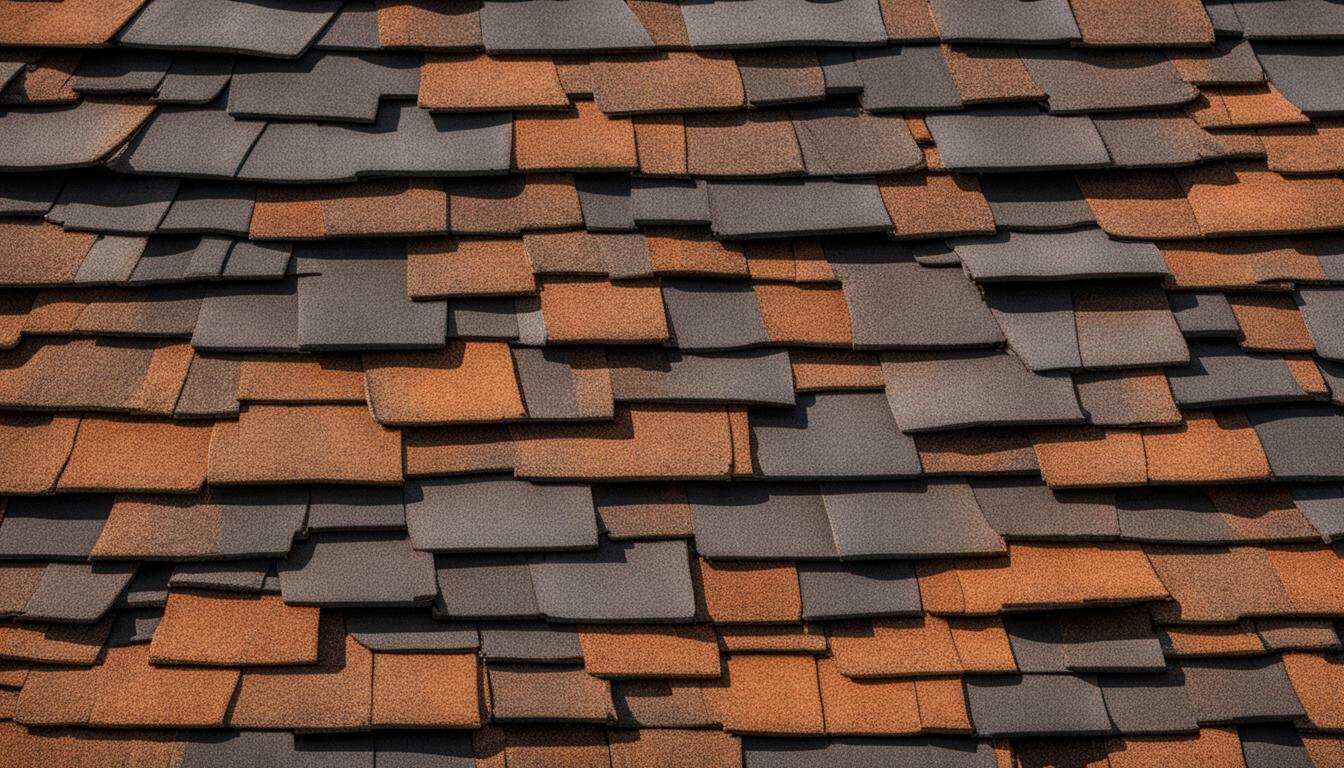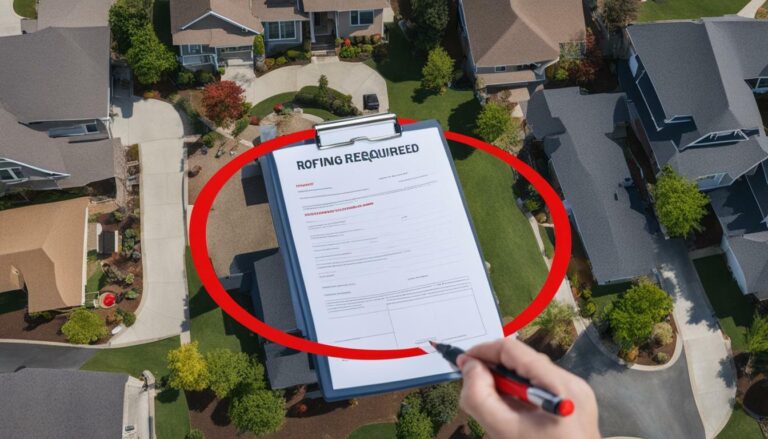Know How Often to Replace Shingles on Your Home
As a homeowner, understanding how often to replace shingles is crucial for ensuring the long-term durability and appearance of your roof. Maintaining a weather-resistant and aesthetically pleasing roof not only adds value to your home but also provides essential protection against the elements.
Regular inspections should be conducted twice a year to check for signs of wear and tear on your shingles. These inspections will help you identify loose, cracked, or damaged shingles, missing shingles, sagging, mold or rot, signs of water damage or leaking, holes, or dark spots. Addressing any issues promptly can prevent further damage and extend the lifespan of your roof.
The recommended replacement schedule for different shingle materials is as follows:
- Composition shingles: 12-20 years
- Asphalt shingles: 15-30 years
- Wood shingles: 20-25 years
- Rubber roofs: 30-50 years
- Metal roofs: 50-75 years
It’s important to note that these timeframes are general guidelines, and the lifespan of your shingles can be influenced by various factors. Climate, severe storms, and high winds can all impact the durability of your roof. Regular maintenance, such as keeping your gutters clean and ensuring proper ventilation, can help prolong the life of your shingles.
Key Takeaways:
- Regular inspections are essential for identifying worn-out or damaged shingles.
- The recommended replacement schedule for shingle materials varies, with composition shingles lasting 12-20 years, asphalt shingles lasting 15-30 years, wood shingles lasting 20-25 years, rubber roofs lasting 30-50 years, and metal roofs lasting 50-75 years.
- External factors such as climate, severe storms, and high winds can affect the lifespan of your shingles.
- Promptly addressing any shingle damage or leaks can prevent further deterioration and extend the longevity of your roof.
- Regular maintenance and inspections, along with proper ventilation and clean gutters, can help prolong the life of your shingles.
Signs of Worn-Out Shingles
Over time, shingles can deteriorate due to age, weather exposure, and other factors, making it important to be aware of the signs of worn-out shingles. Regular inspections can help identify any issues early on and prevent further damage to your roof. Here are some key indicators that your shingles may need replacement:
- Curling or Buckling: Shingles that are curling at the edges or buckling in the middle are a clear sign of wear. This can happen due to age or improper installation.
- Cracked or Missing Shingles: Cracks or missing shingles leave your roof vulnerable to leaks and water damage. Replace any damaged or missing shingles to maintain the integrity of your roof.
- Granule Loss: Excessive granule loss from shingles can indicate that they are nearing the end of their lifespan. Look for granules in your gutters or downspouts.
- Moss or Algae Growth: The presence of moss or algae on your shingles can indicate moisture retention and potential damage. It’s important to address this issue promptly to prevent further deterioration.
If you notice any of these signs, it’s recommended to consult with a professional roofer for a thorough inspection and to determine if shingle replacement is necessary. Ignoring these signs can lead to more extensive and costly repairs in the future.
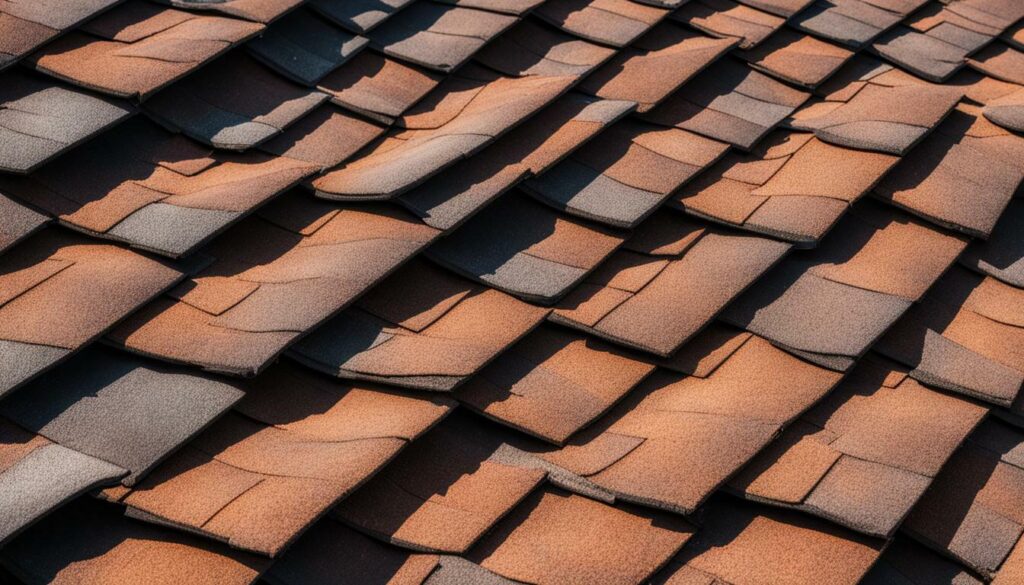
Remember, the average lifespan of different shingle materials may vary. It is important to consider the specific type of shingles on your roof and their recommended replacement interval. Regular maintenance, including periodic inspections, can help prolong the life of your roof and ensure its effectiveness in protecting your home from the elements.
Regular Inspections for Shingle Maintenance
To keep your roof in top shape, regular inspections and maintenance of your shingles are essential. Conducting inspections twice a year, ideally in the spring and fall, will help you identify any potential issues and address them promptly, preventing further damage and extending the lifespan of your roof.
During your inspections, pay close attention to any signs of wear and tear on your shingles. Look for loose, cracked, or damaged shingles, as well as missing shingles, sagging areas, and signs of mold, rot, or water damage. These issues can weaken the integrity of your roof and lead to leaks and further deterioration if left unaddressed.
Additionally, inspect your roof for any holes or dark spots, as they may indicate underlying issues such as pests or trapped moisture. It’s important to note that different materials have varying replacement schedules. Composition shingles typically last between 12-20 years, while asphalt shingles have an average lifespan of 15-30 years. Wood shingles can last around 20-25 years, rubber roofs can endure for 30-50 years, and metal roofs have an impressive lifespan of 50-75 years.
Factors such as climate, severe storms, and high winds can affect the longevity of your shingles. If you live in an area prone to extreme weather conditions, it’s crucial to be extra vigilant in monitoring your shingles for any signs of damage. Addressing any issues promptly and conducting regular maintenance can help prolong the life of your roof and protect your home from potential water damage or other costly issues.

- Always prioritize safety when replacing roof shingles. Use proper protective gear such as gloves, safety glasses, and a sturdy ladder.
- If you notice any damaged or missing shingles, it’s best to replace them as soon as possible. This will prevent further damage and minimize the risk of leaks.
- When removing old shingles, be careful not to damage the underlying structure. Use a pry bar or shingle removal tool to gently lift the shingles and nails.
- Ensure the new shingles match the existing ones in terms of color, material, and size to maintain a cohesive appearance.
- Use a roofing adhesive or roofing nails to secure the new shingles in place, following the manufacturer’s instructions and any local building codes.
- Consider hiring a professional roofing contractor for complex repairs or if you’re unsure about the process. They have the expertise and equipment to ensure the job is done correctly and safely.
By following these maintenance tips and staying vigilant with regular inspections, you can keep your shingles in optimal condition and protect your home from potential roof issues. Remember, a well-maintained roof is not only aesthetically pleasing but also crucial for the overall integrity and value of your property.
| Shingle Material | Replacement Frequency |
|---|---|
| Composition Shingles | 12-20 years |
| Asphalt Shingles | 15-30 years |
| Wood Shingles | 20-25 years |
| Rubber Roofs | 30-50 years |
| Metal Roofs | 50-75 years |
Source: Factual data
Composition Shingles Replacement Frequency.
Composition shingles typically have a lifespan of 12-20 years, but various factors can influence how long they last. These factors include the quality of the shingles, the climate in which they are installed, and the level of maintenance they receive. Regular inspections and prompt repairs are essential for ensuring the longevity of composition shingles.
When it comes to composition shingles, it is important to monitor their condition regularly. Twice a year, in spring and fall, you should conduct a thorough inspection of your roof to check for any signs of damage or wear. Look for loose or cracked shingles, missing shingles, sagging areas, mold or rot, signs of water damage or leaking, holes, or dark spots. Addressing these issues promptly can prevent further deterioration and extend the lifespan of your composition shingles.
Additionally, it is crucial to consider the climate in which your home is located. Extreme weather conditions, such as heavy rains, high winds, or intense heat, can significantly impact the lifespan of your shingles. If you live in an area with severe weather patterns, you may need to replace your composition shingles more frequently.
In conclusion, composition shingles typically last between 12-20 years, but their lifespan can be influenced by various factors. Regular inspections, prompt repairs, and taking into account the climate in your area are important for maintaining the condition and prolonging the life of your composition shingles. By following these guidelines, you can ensure that your roof remains durable, weather-resistant, and aesthetically pleasing for many years to come.
Asphalt Shingles Replacement Frequency
Asphalt shingles, one of the most popular roofing materials, typically have a lifespan of 15-30 years, but certain factors can impact their longevity. To ensure the optimal performance of your asphalt shingles, regular inspections and maintenance are essential. Twice a year, it is recommended to inspect your roof for any signs of wear and tear.
During these inspections, carefully check for loose, cracked, or damaged shingles, missing shingles, sagging, mold or rot, signs of water damage or leaking, holes, or dark spots. Addressing any damage or leaks promptly can prevent further deterioration and extend the lifespan of your asphalt shingles.
While the average lifespan of asphalt shingles falls within the range of 15-30 years, the actual duration can vary depending on various factors. Climate plays a significant role, as extreme temperatures, prolonged exposure to the sun, and frequent freeze-thaw cycles can accelerate the deterioration of the shingles. Additionally, severe storms with high winds and heavy rain can cause significant damage to asphalt shingles, reducing their lifespan.
To summarize, regular maintenance and inspections are crucial for identifying and addressing issues with your asphalt shingles promptly. By following these best practices and paying attention to the signs of wear and tear, you can maximize the lifespan of your asphalt shingles and ensure the long-term durability of your roof.
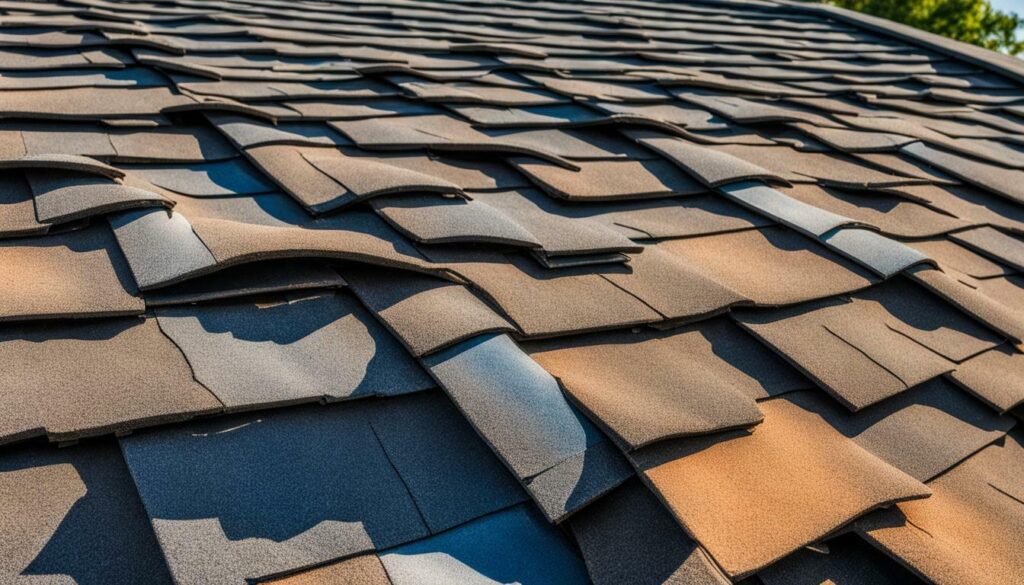
| Roofing Material | Recommended Lifespan |
|---|---|
| Composition Shingles | 12-20 years |
| Asphalt Shingles | 15-30 years |
| Wood Shingles | 20-25 years |
| Rubber Roofs | 30-50 years |
| Metal Roofs | 50-75 years |
Wood Shingles Replacement Frequency
Wood shingles can last approximately 20-25 years, but they require regular maintenance to ensure their durability. Proper care and attention are needed to protect them from the elements and extend their lifespan. Here are some essential tips to keep your wood shingles in top condition:
- Inspect your roof twice a year, in the spring and fall, to identify any signs of damage or wear. Look for cracked or broken shingles, loose nails, or signs of rot and decay.
- Keep the roof clean by removing any debris such as leaves, twigs, or moss that may accumulate. These can trap moisture and cause damage to the wood over time.
- Trim any overhanging branches that may come into contact with the roof. Falling branches or rubbing against the shingles can cause scratches, cracks, or other forms of damage.
- Regularly apply a wood preservative or sealant to protect the shingles from moisture, UV rays, and fungal growth. This will help maintain their natural beauty and increase their resistance to weathering.
By following these maintenance practices, you can prolong the lifespan of your wood shingles and enjoy a beautiful and reliable roof for many years to come.
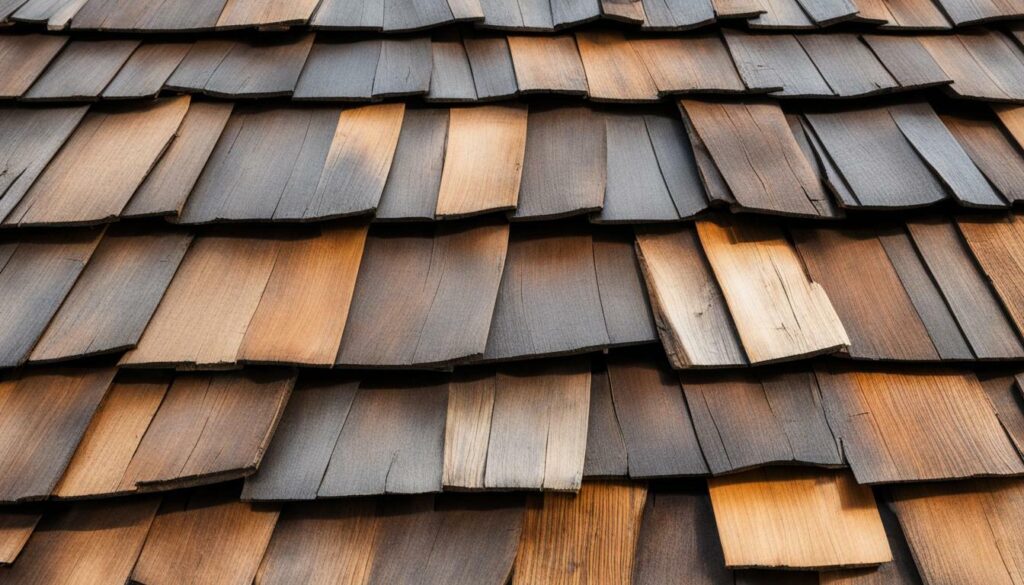
Remember, prevention is key when it comes to preserving the integrity of your roof. Promptly address any issues or signs of damage to prevent further deterioration. Regular inspections and maintenance can save you from costly repairs down the line.
Rubber Roofs Replacement Frequency
Rubber roofs are known for their durability, with an average lifespan of 30-50 years, but various elements can impact their longevity. Proper maintenance and regular inspections are essential to ensure that your rubber roof remains in optimal condition for its entire lifespan. Understanding the factors that can affect the durability of rubber roofs will help you make informed decisions about maintenance and replacement.
In addition to routine inspections, it is important to be aware of the specific signs that indicate your rubber roof may need replacement. These signs can include cracking, blistering, or peeling of the rubber membrane, as well as significant shrinkage or visible damage caused by severe weather conditions. Regularly checking for these indicators will allow you to address any issues promptly and prevent further damage to your roof and home.
When it comes to the replacement frequency of rubber roofs, it is important to note that the lifespan can vary based on factors such as climate and exposure to extreme weather conditions. Rubber roofs in areas with harsh climates or frequent severe storms may experience a shorter lifespan compared to those in more moderate environments. It is advisable to consult with a roofing professional to determine the specific replacement schedule for your rubber roof based on your location and local weather patterns.
To ensure the longevity of your rubber roof, consider implementing a regular maintenance routine that includes cleaning debris, inspecting for damage, and addressing any issues promptly. By taking proactive measures and staying vigilant, you can extend the lifespan of your rubber roof and protect your home from potential water damage or other costly issues.
| Material | Lifespan |
|---|---|
| Rubber Roofs | 30-50 years |
Metal Roofs Replacement Frequency.
Metal roofs are renowned for their exceptional durability, with an average lifespan of 50-75 years, but certain considerations can influence their longevity. Proper maintenance and regular inspections are key to ensuring your metal roof performs at its best.
When it comes to metal roofs, one of the most important factors affecting their lifespan is the quality of installation. Improper installation can lead to issues such as leaks, rust, and poor structural integrity. Therefore, it is crucial to hire a professional roofing contractor with experience in installing metal roofs.
In addition to installation, climate plays a significant role in the longevity of metal roofs. Extreme temperatures and harsh weather conditions can cause expansion and contraction, which may result in damage over time. Regular inspections should be conducted after severe storms or high winds, as these events can potentially cause dents or dislodgment of metal panels.
Proactive measures, such as removing debris and keeping the roof clean, can also help extend the lifespan of your metal roof. Regularly inspecting for any signs of rust, loose fasteners, or damaged seams is essential. If any issues are detected, they should be addressed promptly to prevent further deterioration.
| Metal Roofs Replacement Frequency | Average Lifespan |
|---|---|
| Steel | 50-75 years |
| Aluminum | 50-75 years |
| Copper | 50-75 years |
Choosing a metal roof offers long-term benefits, as they provide superior resistance against elements such as fire, hail, and strong winds. Their durability makes them a popular choice for homeowners seeking a long-lasting roofing solution.
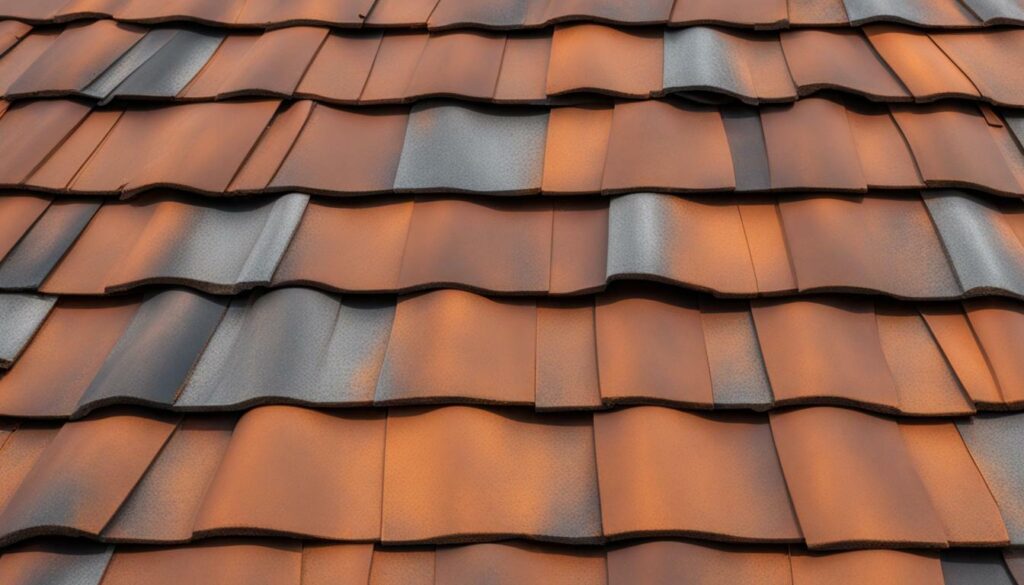
- Proper installation by an experienced professional is crucial for the longevity of metal roofs.
- Climate and extreme weather conditions can impact the performance of metal roofs.
- Maintaining a clean and debris-free roof helps extend its lifespan.
- Regular inspections and prompt repairs are essential for addressing any issues promptly.
Investing in a metal roof for your home provides peace of mind and long-lasting protection. By following these guidelines and taking proactive measures, you can ensure your metal roof withstands the test of time.
Factors Affecting Shingle Lifespan
Various external factors, such as climate conditions, severe storms, and high winds, can significantly affect the lifespan of your shingles. Understanding how these elements impact your roof’s durability is crucial for proper maintenance and timely replacement. Here are the key factors that can influence the longevity of your shingles:
- Climate: The climate in your region plays a significant role in determining the lifespan of your shingles. Extreme temperatures, excessive humidity, and frequent temperature fluctuations can cause shingles to deteriorate more quickly. For example, in hot climates, prolonged exposure to intense sunlight can lead to accelerated aging and thermal damage to the shingles.
- Severe Storms: Severe weather events, such as hurricanes, tornadoes, or hailstorms, can cause extensive damage to your roof’s shingles. High winds can lift and dislodge shingles, while hail can bruise or crack them. Heavy rain can lead to water infiltration and subsequent rot or mold growth. Regularly inspecting your roof after severe storms is crucial to identifying and addressing any damage promptly.
- High Winds: Wind can cause shingles to lift, crack, or tear off, leaving your roof vulnerable to leaks and further damage. The severity of wind damage depends on the wind speed, duration, and the quality of the shingles. If you live in an area prone to strong winds, consider using shingles designed to withstand high wind speeds.
By being aware of these factors, you can take proactive measures to protect your shingles and extend their lifespan. Regular inspections, especially after extreme weather events, can help you identify any damage early on and address it promptly. Timely repairs or replacements can prevent further deterioration and potentially save you from more extensive and costly repairs down the line.

Remember, maintaining a weather-resistant and aesthetically pleasing roof not only enhances the curb appeal of your home but also ensures the protection of your property and loved ones. Be proactive in monitoring your roof’s condition, and consult with roofing professionals if you are unsure about the extent of damage or the need for replacement. With proper care and attention, your shingles can provide reliable protection for years to come.
Conclusion
Understanding how often to replace shingles and implementing regular inspections and maintenance practices are key to ensuring the longevity and effectiveness of your roof. Knowing when to replace the shingles on your home is crucial for maintaining the integrity of your roof and protecting your investment. Regular inspections should be conducted at least twice a year to check for any signs of damage or deterioration.
During these inspections, be on the lookout for loose, cracked, or damaged shingles, missing shingles, sagging, mold or rot, signs of water damage or leaking, holes, or dark spots. Addressing any issues promptly can prevent further damage and costly repairs in the future.
The recommended replacement schedule for different shingle materials is as follows: composition shingles typically last 12-20 years, asphalt shingles have an average lifespan of 15-30 years, wood shingles can last 20-25 years with proper maintenance, rubber roofs have a lifespan of 30-50 years, and metal roofs are known for their impressive longevity, lasting 50-75 years.
However, it’s important to note that external factors such as climate, severe storms, and high winds can significantly affect the lifespan of your shingles. Harsh weather conditions can accelerate wear and tear, leading to the need for more frequent replacements. Regular maintenance and inspections, along with timely repairs, can help prolong the life of your roof and ensure its ability to withstand the elements.
In conclusion, stay proactive when it comes to your roof’s maintenance. Regularly inspect your shingles, address any issues promptly, and follow the recommended replacement schedule for your specific shingle material. By doing so, you can avoid costly repairs and ensure the long-term functionality and durability of your roof.
FAQ
Q: How often should I replace the shingles on my home?
A: The recommended replacement schedule for different materials is as follows: composition shingles (12-20 years), asphalt shingles (15-30 years), wood shingles (20-25 years), rubber roofs (30-50 years), and metal roofs (50-75 years).
Q: What are the signs of worn-out shingles?
A: Signs of worn-out shingles include loose, cracked, or damaged shingles, missing shingles, sagging, mold or rot, signs of water damage or leaking, holes, or dark spots.
Q: How often should I conduct shingle inspections?
A: Regular inspections should be conducted twice a year to check for any damage or issues with the shingles.
Q: How do I maintain my shingles?
A: To maintain your shingles, it is important to promptly address any damage or leaks, conduct regular inspections, and perform necessary repairs or replacements.
Q: What affects the lifespan of shingles?
A: Factors such as climate, severe storms, and high winds can affect the lifespan of shingles. These external factors can cause accelerated wear and tear.
Q: How can I prolong the life of my roof?
A: Regular maintenance and inspections can help prolong the life of your roof. Promptly addressing any damage or leaks and conducting necessary repairs or replacements can prevent further deterioration.
